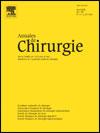Évaluation de l'efficacité de la somatostatine ou de l'octréotidedans le traitement des fistules pancréatiques externes - 01/01/01
L.
Brunaud ,
H.
Sebbag,
F.
Marchal,
A.
Verdier,
L.
Bresler,
J.M.
Tortuyaux,
P.
BoisselCorrespondance et tirés à part
,
H.
Sebbag,
F.
Marchal,
A.
Verdier,
L.
Bresler,
J.M.
Tortuyaux,
P.
BoisselCorrespondance et tirés à part
Riassunto |
But de l'étude : Évaluer la prévalence de l'apparition d'un pseudokyste après tarissement d'une fistule pancréatique persistante traitée par une somatostatine de synthèse ou l'octréotide. Comparer les caractéristiques des patients en fonction de l'apparition ou non d'un pseudokyste après le tarissement fistuleux.
Patients et méthodes : Cette étude rétrospective entre janvier 1994 et août 1999 a porté sur 15 patients ayant une fistule pancréatique tarie après traitement par somatostatine ou octréotide. Une tomodensitométrie a été réalisée chez tous les patients 66 ± 34 jours après la fin du traitement. Les patients ont été séparés en groupe échec ou en groupe favorable en fonction de la présence ou non d'un pseudokyste.
Résultats : La tomodensitométrie était normale neuf fois sur 15 (60 %) (groupe favorable) et a objectivé un pseudokyste pancréatique dans six cas (groupe échec). Les cinq patients ayant une fistule dans les suites d'une duodénopancréatectomie céphalique ont tous fait partie du groupe favorable. Six des dix patients qui avaient une fistule après drainage d'un pseudokyste ont fait partie du groupe échec. Aucune autre différence significative n'a pu être mise en évidence entre les deux groupes.
Conclusion : La somatostatine ou l'octréotide peuvent être efficaces en cas de fistule pancréatique persistante. Ces résultats dépendent de l'étiologie de la fistule. Les fistules pancréatocutanées (FP) survenant après duodénopancréatectomie céphalique semblent pouvoir être traitées efficacement par la somatostatine ou l'octréotide. En revanche, la somatostatine ou l'octréotide ne peuvent pas être considérés comme un traitement efficace des FP persistantes après drainage externe d'un pseudokyste, même si quatre cas sur dix ont été traitées efficacement.
Mots clés : fistule pancréatique ; pancréas ; pseudokyste du pancréas ; somatostatine.
Abstract |
Aim of the study: To evaluate the prevalence of pancreatic pseudocyst after persistent fistula closure with somatostatin or octreotide. To compare the patient characteristics according to the subsequent presence or absence of pseudocyst.
Patients and methods: This retrospective study from January 1994 to August 1999 included 15 patients with an external pancreatic fistula. Fistula closure was observed for all patients with somatostatin or octreotide. CT scan was performed 66 ± 34 days after the end of this treatment.
Results: CT scan was normal in 9 patients (favorable group) and showed pancreatic pseudocyst (failure group) in 6 patients. Pancreatic fistula etiologies were different between the two groups. The 5 patients presenting pancreatic fistula after duodenopancreatectomy belonged to the favorable group. Six of the 10 patients presenting pancreatic fistula after pseudocyst drainage belonged to the failure group. There were no other differences between the two groups.
Conclusion: Persistent pancreatic fistula can be cured with somatostatin or octreotide. However, fistulas occurring after duodenopancreatectomy are more easily cured with somatostatin or octreotide than fistulas occurring after external pseudocyst drainage. Somatostatin or octreotide cannot be considered to be an effective treatment for pancreatic fistula occurring after pseudocyst drainage, despite the fact that 40% of them were permanently cured.
Mots clés : pancreatic fistula ; pancreas ; pseudocyst of the pancreas ; somatostatin.
Mappa
Vol 126 - N° 1
P. 34-41 - Febbraio 2001 Ritorno al numeroBenvenuto su EM|consulte, il riferimento dei professionisti della salute.

